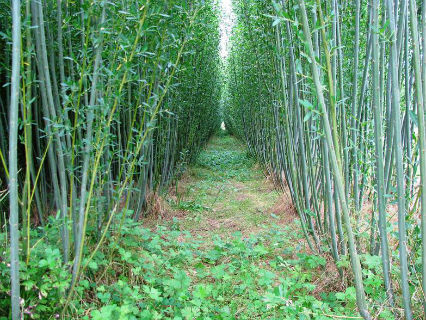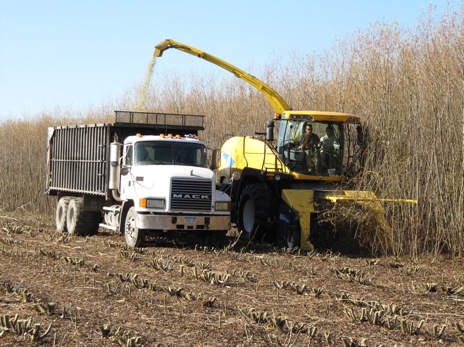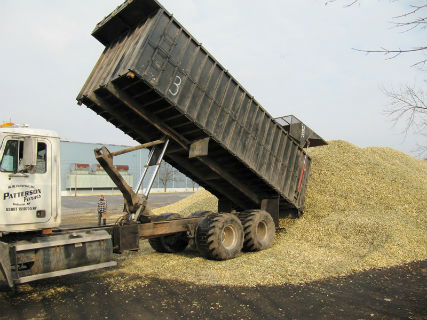Harvest method impacts wood chip quality–use a single-pass cut-and-chip method and willow makes the grade.

Table of Contents
- Introduction
- Research Purpose
- Research Activities
- What We Have Learned
- Why This Is Important
- Future Plans
- For More Information
- Contributors to This Summary
Introduction
Biomass for bioenergy and/or bioproducts can be sourced from forests, agricultural crops, various residue streams, and dedicated woody or herbaceous bioenergy crops. Despite this wide spectrum of promising feedstocks, no single biomass source can meet the projected demand, or is clearly superior to alternatives in all aspects of cost, quality, and acceptance.
Shrub willow biomass crops can be grown on a range of agricultural land (including marginal land) using a coppice management system that allows multiple harvests on three- to four-year cycles from a single planting of improved shrub willow cultivars. Despite the benefits of these systems, their expansion and deployment has been constrained by higher production costs and lower market acceptance due to a perception of poor chip quality and inconsistent wood characteristics compared to forest biomass.

Most of the available data on the characteristics of willow biomass crops, such as moisture, ash and energy content, comes from material that was hand harvested from small-scale yield trials. However, these hand-harvested samples might not represent the amount of variability in biomass characteristics when material is harvested with large machinery at commercial scales. Significant variation in characteristics creates problems and reduces the efficiency of facilities that convert this biomass into renewable biofuels, heat, or power.
Research Purpose
This research project at the SUNY College of Environmental Science and Forestry (SUNY ESF) studied how commercial-scale harvesting might influence the characteristics of harvested willow chips.
In 2008, CNH Industrial (CNHi) began developing a prototype short-rotation coppice header (130FB) for its New Holland FR9000 series of forage harvesters. This header is specifically designed to cut and chip a range of short rotation woody crops (SRWC) such as willow, poplar, and eucalyptus. A research team from the SUNY ESF evaluated the characteristics willow biomass produced during a commercial-scale harvest using this harvester. They also assessed how the biomass complied with a published biomass standard, and contrasted it with biomass produced from small-scale, hand-harvested field trials. The study evaluated ash, moisture, and energy content; selected elements (N, P, K, Ca, Cu, Mg, Na, S, and Zn); and particle size distribution.

Research Activities
The team harvested approximately 150 acres of shrub willow over 10 days in late 2012 and early 2013 at two sites in Auburn and Groveland, New York. More than 2,500 tons of chipped biomass material were generated and delivered to short-term storage in more than 200 loads. A one- to two- kilogram sample was collected from each load, and laboratory analysis was performed.
Each load was compared for compliance with the recently published standard for graded wood chips (ISO 17725-4:2014), although the requirements of specific end users may vary. Characteristics of the biomass were compared to willow chips that were hand harvested from nearby field trials.
What We Have Learned
The harvesting system produced consistently-sized biomass chips that met biorefinery and power producing partners’ specifications for wood chips.
Ash: Compared to hand-harvested willow biomass, the mean ash content of commercial scale samples was almost 1 percentage point higher and had wider variation. The mean ash content of the 224 commercially harvested samples was 2.1% (SD 0.59) and ranged from 0.8-3.5% on a dry weight basis. The ISO 17225-4 threshold for B1 chips is <3% ash content; this cutoff was met by all of the Auburn site samples, and 82% of those from the Groveland site. Slight differences were also found in the ash content between some willow cultivars that were grown at these sites. Most notably, the average ash content of the cultivar Fish Creek (1.3%) was significantly lower than other cultivars tested, which had ash contents up to 2.4%.

Moisture: The mean moisture content of the biomass from the commercial harvests was 44%, ranging between 37 and 51%. Moisture contents for the hand-harvested willow biomass samples used for comparison ranged between 45 and 56%, with a mean moisture content of 46%. The only requirement in ISO standard is that the moisture content is reported for this kind of material.

Energy Content of biomass is typically reported in two ways. Willow is similar to most hardwoods species in the northeast United States.
The higher heating value is the energy content of the biomass on a dry basis. For the commercial samples in this study, it was 18.6 MJ kg-1 (SD ±1.8). In comparison, the hand-harvested samples had a higher heating value of 18.8 MJ kg-1 (SD ±1.8).
The lower heating value accounts for the energy that is used to turn the water in the biomass into steam and is impacted by the moisture content of the biomass and some other factors. This is the net amount of energy that will be available to an end user of the biomass. For the commercially harvested willow, the lower heating value was 10.4 MJ kg-1. Because the moisture content of the hand-harvested willow was slightly higher, the lower-heating value of the hand-harvested material was slightly lower at 10.1 MJ kg-1.
Size: The biomass met the P45S specifications in the ISO 17225-4 standard. This means that less than 1% of the biomass was greater than 45 mm in size and more than 95% of the chips were between 6.35 mm and 45mm. If an end user requires a different chip size, this can be accommodated by adjusting the speed of the feedrolls or the number of knives on the harvester drum.

Why This Is Important
It is important to understand the amount of variation in biomass characteristics in material that is harvested at a commercial scale. Large changes in essential characteristics such as ash or moisture content can cause problems for end users by decreasing the efficiency of the conversion process or damaging boilers or bio-reactors. Being able to produce willow biomass with a consistent set of characteristics will allow end users to adjust their processes to best use it.
Previous perceptions of willow biomass created barriers to its acceptance as a useful source of woody biomass. In particular, it was often assumed that willow biomass was wetter than other hardwood chips and had higher ash content. Willow biomass chips produced with previous harvesting systems tended to create long, stringy pieces that clogged biomass handling systems. This research should help change that perception. Data from willow biomass harvested from a large number of acres has shown that consistently sized material with a small amount of variation in ash and moisture content can be produced using the New Holland single-pass cut and chip harvester. In addition, the essential characteristics of willow biomass (energy, ash, and moisture content) are similar to other hardwoods. Sharing this information with potential end users and others interested in biomass will help people make informed decisions about willow as a biomass source.

The results also suggest that there might be ways to further reduce the variability of willow biomass harvested across large areas. Mixing different cultivars either in the field or during harvesting can mitigate quality problems. For example, cultivars that have been identified in this and other studies as having low ash (e.g., Fish Creek or SV1) could be interplanted, essentially creating mixed or blended feedstocks at the point of production.
Future Plans
This research describes the characteristics of willow biomass just after it is harvested. Changes in some of these characteristics can occur during handling, storage, and transportation of the biomass. Evaluating these changes and developing best management practices is the next important step in understanding the supply chain for willow biomass. It might be possible to improve some characteristics such as moisture content by natural drying of the material or minimizing others such as limiting contamination with dirt from storage locations or in transportation vehicles.
For More Information
- Timothy Volk (315-470-6774, tavolk@esf.edu)
- Eisenbies M, T Volk, J Posselius, S Shi, A Pattel. (2014) Quality and Variability of Commercial-Scale Short Rotation Willow Biomass Harvested Using a Single-Pass Cut-and-Chip Forage Harvester Bioenergy Research. DOI 10.1007/s12155-014-9540-7
- Eisenbies M, T Volk, J Posselius. Research Summary: Development of a Single-Pass Cut-and-Chip Harvesting System for Short Rotation Woody Crops
- Video of Northeast Bioenergy Webinar: Willow Biomass Harvest & Quality
- International Organization for Standardization (ISO) standard for graded wood chips: ISO 17225-4:2014
Contributors to This Research Summary
Authors
- Mark Eisenbies, Research Scientist, SUNY College of Environmental Science and Forestry
- Timothy Volk, Senior Research Associate, SUNY College of Environmental Science and Forestry
- John Posselius, CNH Industrial America LLC
Peer Reviewer
- Jingxin Wang, Professor of Wood Science & Technology, Director of Biomaterials & Wood Utilization Research Center, West Virginia University
This work was made possible by the funding under award #EE0001037 from the US Department of Energy Bioenergy Technologies Office, New York State Research and Development Authority (NYSERDA), the Empire State Development Division of Science, Technology and Innovation (NYSTAR) and through the Agriculture and Food Research Initiative Competitive Grant No. 2012-68005-19703 from the USDA National Institute of Food and Agriculture.
 The Northeast Woody/Warm-season Biomass Consortium – NEWBio is supported by Agriculture and Food Research Initiative Competitive Grant no. 2012-68005-19703 from the USDA National Institute of Food and Agriculture.
The Northeast Woody/Warm-season Biomass Consortium – NEWBio is supported by Agriculture and Food Research Initiative Competitive Grant no. 2012-68005-19703 from the USDA National Institute of Food and Agriculture.
Led by Penn State University, NEWBio includes partners from Cornell University, SUNY College of Environmental Science and Forestry, West Virginia University, Delaware State University, Ohio State University, Rutgers University,  USDA’s Eastern Regional Research Center, and DOE’s Oak Ridge National Laboratory and Idaho National Laboratory.
USDA’s Eastern Regional Research Center, and DOE’s Oak Ridge National Laboratory and Idaho National Laboratory.
